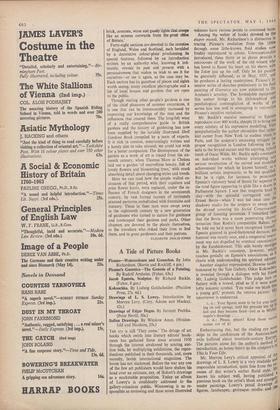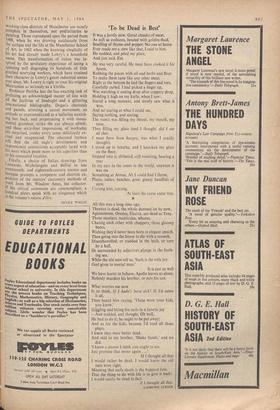A Tide of Picture Books
Picasso—Watercolours and Gouaches. By John By Rudolf Arnheim. (Faber, 63s.) Kokoschka. By Ludwig Goldscheider. (Phaidon Press, 27s. 6d.) Drawings of Edgar Degas. By Jaromir Pecirka. (Peter Nevill, 50s.)
Italian Drawings. By Winslow Ames. (Weiden- feld and Nicolson, 35s.) THE cry is still 'They come.' The deluge of art books which swirls into literary editors' book- cases has gathered force since around 1950 through the interest awakened by soaring auc- tion bids, by multiplying exhibitions, the repro- ductions published in their thousands, and, more recently, lavish international magazines. The boom has not slackened. Before the war any one of the few art publishers would have shaken his head over an estimate, say, of Sickert's drawings as a marketable proposition. Today an album of Lowry's is confidently addressed to the gallery-conscious public. Winnowing is as re- sponsible as reviewing and these seven illustrated
volumes have various points to commend them. Among the welter of books devoted to the stupor mundi, Mr. Richardson's is distinctive in
tracing Picasso's evolution from the 1890s through some little-known fluid studies nog/ freshly reproduced in colour. Unexceptionably introduced, these thirty or so plates provide 3 microcosm of the work of the old wizard who has loved to flaunt his heart on his sleeve with the Joker just up the cuff. Only let his passion be genuinely inflamed, as in May, 1937, and he produces a lasting masterpiece. Picasso's la' tensive series of sketches preliminary to his final painting of Guernica are now subjected to Dr. Arnheim's scrutiny. The formidable equipment this author brings to his philosophical and psychological contemplation of works of art serves him less well in attempting to rationalise Picasso's intuitive variations.
Mr. Buckle's massive memorial to Epstein reproduces over 400 works, sharply lit to bring out every subtlety of his expressive modelling. Vet/ sympathetically the author chronicles that turbo' lent career from New York to student years rn Paris, and the sculptor's unceasing struggle for proper recognition in London following the in' sults to the Strand statues and the aspiring, hybrid tomb of Oscar Wilde. Mr. Buckle aptly comments on individual works without attempting any serious revaluation of the carved and modelled achievement for which he knows himself, as a brilliant artistic impresario, to be less qualified' But he is right, for instance, to pronounce Epstein's visionary head of Smuts far superior t° the total figure appearing to glide like a skater in Parliament Square. I saw that magnetic head in clay—with the splendid corrugated one of Ernest Bevin—when I was led once into the shadowy studio for the sculptor to sweep aside the shroud covering his Social Consciousness group of looming presences. I remarked then that the Bevin was a more penetrating charsc' terisation than Rodin's comparable Balzac, but 'he told me he'd never have recognised himself,' Epstein grunted in good-humoured derision. His humour was mostly sour, and a congenital resent' ment was not dispelled by eventual canonisation by the Establishment. This side barely emerges in Mr. Buckle's testament, however, which touches genially on Epstein's associations, as I charts with understanding his spiritual odyssey Another singular expressionist, likewise tardily honoured by the Tate Gallery, Oskar KokoschIca, is revealed through a dialogue with his friend Mr. Ludwig Goldscheider. This judge lays on flattery with a trowel, plied as if it were sort! lofty masonic symbol. 'You make me blush lit° a young girl,' protests the veteran painter. His interviewer is undeterred.
L. G.: Your figures seem to be for ever turn' ing on coil springs, until the pressure lets uP at last and they become fixed—just as in Michel' angelo's drawings . . . o. K.: Please, please! Keep those sacred names out of it!
Embarrassing this, but the reading eye so00 skips to the confidences of the Austrian-bore • exile buffeted about twentieth-century EUrdPei The pictures atone for the author's method ° introduction, as honey-heavy as the compere's in This Is Your Life. Mr. Mervyn Levy's critical appraisal of tile drawings of L. S. Lowry is a very readable an responsible introduction, quite free from the cesses of this writer's earlier florid style. II` knows his subject well, having published s previous book on the artist's bleak and strangely tender paintings. Lowry's pencil drawings , ocf figures, landscapes, grotesque misfits and 4' working-class districts of Manchester are mostly complete in themselves, not preliminaries to painting. Those reproduced span the period from 1908, when he was drawing assiduously from the antique and the life at the Manchester School of Art, to 1962 when the knowing simplicity of his art had already made Lowry's a household name. This transformation of vision was in- spired by the revelatory experience of seeing a spinning mill disgorging its hundreds of little Pinched scurrying workers, which have retained their character in Lowry's gaunt industrial scenes ever since. Mr. Lowry is right to treat his original Mancunian as seriously as a Utrillo.
Professor Pecfrka has the less exacting task of prefacing an acknowledged master of line with all the facilities of hindsight and a glittering international bibliography. Degas's charcoals and pastels, arresting a casual movement, an attitude as unpremeditated as a ballerina scratch- ing her back, and perpetuating it with monu- mental grandeur, strike the eye always afresh; and these sixty-four impressions, of workaday life surprised, render every sense deliciously ex- cited and unappeased. The educated layman will find the old eagle's development and im.pressionist connections acceptably laced with his mots which point more to his asperities than to his concealed loyalties. Filially, a choice of Italian drawings from Leonardo, Michelangelo and Bellini to late seventeenth- and eighteenth-century rococo and baroque prompts a competent and shortish ex- position of the masters' customary methods of work from Mr. Winslow Ames, the collector. If his critical comments are commonplace, a hundred plates speak with an eloquence which is the volume's raison d'etre.
NEVILE WALLIS















































 Previous page
Previous page